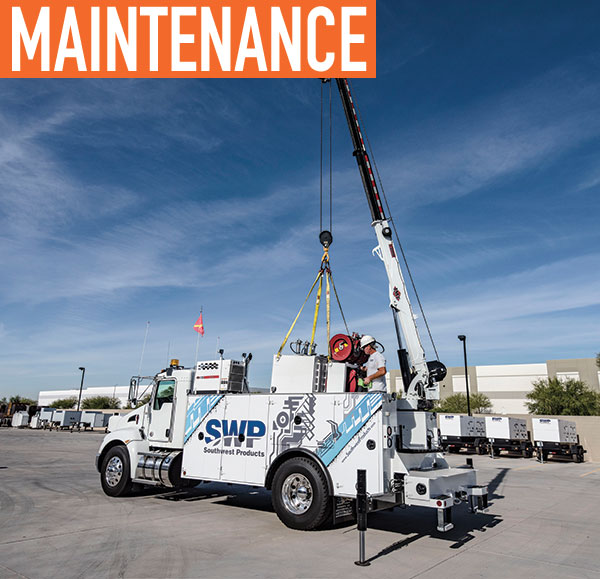Everyone wants to get the most out of their work trucks. In maintenance functions and service applications, efficiency and cost are always battling against the day-to-day needs and malfunctions that plague your equipment. Whether you currently use a mechanic truck, your pickup truck, or a third-party service for equipment maintenance, the time you spend out on jobsites needs to be used as efficiently as possible. That’s why lube skids are growing in popularity—for their ability to expand the capabilities of maintenance programs and work truck fleets, while offering the value and flexibility needed to run your business.
For the occasional remote service needs or to service a limited number of items, a customized lube skid may provide a low-cost alternative compared to purchasing a dedicated lube truck. This cost-effective investment can pay back dividends in saved contractor costs and multiple jobsite trips by expanding your service capabilities without affecting other capital expenditures.
WHY ADD ONE TO YOUR FLEET
One of the biggest benefits of a lube skid is the versatility they offer. A lube skid can be added to many mechanic trucks, placed in the bed of a pickup, or mounted on a trailer and hauled by any truck with a hitch. Their compact size, easy access forklift slots, and sling lifting rings make moving your lube skid easy and simple. When not in use, lube skids can be placed into storage—out of the way and ready to use when needed next.
With a lube skid in the back of your truck, servicing your equipment is a lot easier. The two ways that lube skids are most frequently used are for preventive maintenance and fueling. Whether you service your own equipment or provide equipment servicing solutions, the addition of a lube skid allows you to service equipment with lube and oil more efficiently in the field when equipment unexpectedly needs repairs or while providing other services.
Typically, lube skids offer several product tanks and waste product tanks for you to service your equipment as needed. Fuel, oil, and DEF can all be distributed to your equipment using your lube skid. This has a two-fold advantage: You can better utilize the time of your service technicians, maximizing their service potential, and you can rely on your in-house service team for more of the services your equipment needs. This reduces the cost of your maintenance program by minimizing your dependability on outside service providers, and allows you to better use the expertise your service techs already have.
PURCHASE CONSIDERATIONS
The biggest factors you’ll want to consider when adding a lube skid to your fleet are its size and design, the products you’ll be transporting in it, and the construction of the skid. Here’s a breakdown of each factor and how it can impact your fleet and maintenance capabilities:
- Design: The size of your lube skid can determine the amount of versatility you’ll receive. A larger skid may not be stored as easily, or be as easily mounted on many vehicles. Depending on your vehicle fleet, this may not be an issue for you, but for some, having a lube skid that is sized for use on many different types of work trucks and trailers is essential. For example, Southwest Products builds custom-designed lube trucks that can be sized for mechanic trucks, pickups, or lube trailers and a wide variety of product tanks.
You also will want to consider how much product you use. If your lube skid tanks are too large and hold more product than you frequently use, you risk wasting fuel, lube, and other costly product that expires after some time. Tanks that are too small will lower the efficiency and usefulness of your lube skid. The vehicle or trailer GVW may limit the total volume of products and equipment that can be handled without overload.
Product: A fully-outfitted lube skid can be a game-changer for your maintenance team, but not all lube skids are equipped to transport and provide services with all the products that your equipment may need. While most are designed for basic lube services, not all skids are designed to deliver newer or more specialized products, such as DEF. Depending on your needs, a custom lube skid may be the best option to deliver the products you need.
Skids that have more product tanks can further streamline your maintenance operations and allow you to offer more services in the field. Before you buy, make sure your new lube skid has the proper tanks for the products you need to deliver in the field, as well as excess tanks for waste product storage.
Construction: The base material of your new lube skid can determine how many years of useful service that you’ll receive from it. Steel construction has proven up to the challenge of long years of service on a wide variety of jobsites without degrading. While lube skids made from other materials may be more lightweight, they often can’t stand up to the tests that today’s jobsites often put them through and can require repairs more often. Tanks made from steel can provide a longer life and reduce the risk of costly product spills from failure.
As companies continue to look for ways to best utilize their work trucks and staff, reduce their maintenance costs, and grow share of business with their current customers, lube skids offer a flexible solution.
ABOUT THE AUTHOR:
Brad Bjerke is vice president of vehicles at Southwest Products. Find out more about Southwest Products, visit www.southwestproducts.com.
_______________________________________________________________________
MODERN WORKTRUCK SOLUTIONS: JANUARY 2017 ISSUE
Did you enjoy this article?
Subscribe to the FREE Digital Edition of Modern WorkTruck Solutions magazine.
![]()




